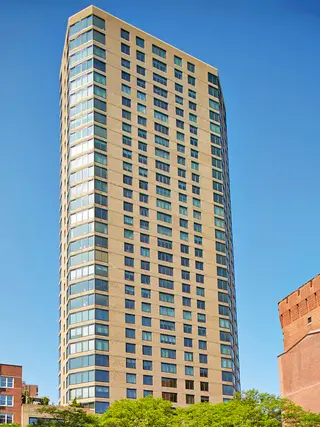 Carter Horsley
Carter HorsleyDec 23, 2011
Carter's Review
With its unusually angled façades and high visibility, Carnegie Hill Tower at 40 East 94th Street on the southeast corner at Madison Avenue is one of the major post-war landmarks of the Carnegie Hill neighborhood, and its creation is a fine testament to the earnest efforts of community leaders to preserve the quality of their neighborhood.
The 32-story building, which was designed by Edward V. Giannasa for developers Frederick DeMatteis and Charles Shaw and completed in 1983, is finely detailed and has a very handsome retail base.
It originally had 223 condominium apartments.
Bottom Line
This tower has very large bay windows with fabulous views south and west in excellent Carnegie Hill location near several nice restaurants and fine museums and excellent schools.
Description
The distinctive massing that emphasizes large bay windows looking south, down Madison Avenue, and its asymmetrical façades, make its otherwise bland, pale-beige masonry façade, quite palatable, and its considerable height gives its residents spectacular views.
Amenities
The building has a doorman, a gym, a live-in superintendent, cold storage, a bicycle room, a roof deck, a garden and a garage.
The very attractive and charming design of the landscaped mews has a waterfall and extends to 93rd Street.
Apartments
The building has many different angled layouts.
Apartment 4K is a one-bedroom unit with a triangular, 10-foot-wide entry foyer that leads to a 22-foot-long living room with an angled wall and a 9-foot-long kitchen.
Apartment 5B is a one-bedroom unit with a 21-foot-long angled living room that opens onto a very large angled terrace.
Apartment 10F is a one-bedroom unit that has a long entry foyer that leads to an enclosed kitchen next to its angled 21-foot-wide living room with a very large bay window.
Apartment 18C is a one-bedroom unit with an entry foyer opening past a pass-through kitchen onto a 20-foot-wide, angled living room with pocket doors leading to a 17-foot-long den.
Apartment 22A is a two-bedroom unit with a long entry foyer that leads past a 15-foot-long dining room to a 20-foot-square angled living room with a very large bay window. The apartment has an 8-foot-long kitchen, a 16-foot-long office and its master bedroom has a 19-foot-long sitting room.
Apartment 32C is a three-bedroom unit with an entry that leads to a 15-foot-long kitchen and a 33-foot-long living room with a wood-burning fireplace and a very large bay window.
Apartment 31D is a five-bedroom unit with an entry foyer that leads to an angled 25-foot-long living/dining room next to a 17-foot-long kitchen with a pass-through to a 27-foot-long angled family room with a 13-foot-long sitting room alcove. The unit also has a 17-foot-long den and a 40-foot-long gallery.
History
Whereas the Upper East Side, north of 86th Street, was long considered rather declassé. This particular area is now prime, especially for families as many prestigious private schools and pleasant restaurants and fine museums are nearby.
H. R. Shapiro, a leading residential developer, encountered serious opposition from residents on the site who hired their own architects, Terry G. Twitchell and Nancy Ai-Tseng Miao, to design an alternative plan to his.
After considerable controversy, the developer agreed to a special zoning amendment for the site and the community design for which he received a "density" bonus for preserving an apartment house, known as the Alamo, at 55 East 93rd Street, and creating a mid-block mews. Philip Birnbaum and Gruzen and Partners were the developers' architects.
Shapiro subsequently encountered financial difficulties, and was replaced by Mr. DeMatteis and Mr. Shaw. Mr. Shaw was the developer of Lake Point Tower, one of the greatest post-war residential skyscrapers in Chicago.
The sensible preservation plan helped minimize the impact of a tall tower in the neighborhood, while preserving an attractive older property, and minimizing the impact of relocation for affected residents.
The tower is directly south of the "ruins" of the Squadron A Armory, on Madison Avenue, behind which there is a very large playground that is part of the Hunter College Campus Schools. This was originally Intermediate School 29, designed by Morris Ketchum Jr. & Associates, in a style to complement the fortress-like design of the former armory.
The building is not part of the Carnegie Hill Historic District.

- Condo built in 1983
- 1 apartment currently for sale ($1.3M)
- 1 apartment currently for rent ($0)
- Located in Carnegie Hill
- 223 total apartments 223 total apartments
- 10 recent sales ($985K to $6.2M)
- Doorman
- Pets Allowed
 6sqft delivers the latest on real estate, architecture, and design, straight from New York City.
6sqft delivers the latest on real estate, architecture, and design, straight from New York City.
